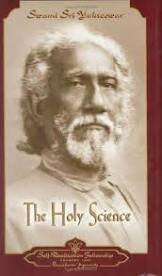This is the original version of The Holy Science by Sri Yukteswar (1894) is in the public domain, which is on the following pages.
The purpose of this present volume is to show as clearly as possible that there is an essential unity in all religions, that there is no difference in the truths inculcated by the various religions prevalent, that there is but one method by which the world both external and internal, has been evolved; and that there is but one goal admitted by all the religious books. But it is not easy to comprehend this basic truth. The discord existing between the different religions of the world and the ignorance of men make it almost impossible to lift the veil and have a look at this grand truth. The creeds keep up and foster the spirit of hostility and breed a feeling of perpetual dissension, and ignorance widens the gulf that separates one creed from another. Only a few specially gifted can rise superior to the influence of their professed creeds and find absolute unanimity in the truths propagated by all the great religions of the world.
As the object of this book is to harmonize the different religions of the world and to bind them together, it will create a real brotherhood among all of the followers of all religions. This is indeed a herculean task for a man like myself. But I was entrusted with this mission by a holy command. The genesis of this book is very interesting. In January 1894 A.D., corresponding to the year 194 of the Dwapara Era the great Kumba Mela which is held at the interval of every twelve years was held at Allahabad, the sacred Prayag-tirtha - the place of confluence of the holy waters of the Ganges and Jumna and also of the intercurrent of Swaraswati.
The Kumbha Mela is the congregation of the worldly men and spiritual devotees. The worldy men cannot transcend the mundane limit with which they confine themselves nor the other having once renounced the world deign to come down and mix themselves with the termoils of the world. The world with its ordinary ways and with men wholly engrossed in worldly concerns stands in infinite need of help and guidance from those holy being who will bring light to the world.
So a place there must be where union between the two sets is possible. Tirtha affords such a meeting place. Situated as it is on the beach of the world, storms and buffets touch it not; the sadhus (ascetics) with a message for the benefit of humanity find a Kumbha Mela to be an ideal place to impart instruction to those who can heed it.
A message of such a nature was I chosen to propagate when I paid a visit to the Kumbha Mela being held at Allahabad in January 1894. As I was walking along the bank of the Ganges, I was summoned by a man and was afterwards honored by an interview with a great holy person, Babaji, the gurudeva of my own guru, Lahiri Mahasaya, of Banaras. This holy personage at the Kumbha Mela was thus my own paramguruji maharaj, though this was our first meeting.
During my conversation with Babaji, we spoke of the particular class of men who now frequent these places of pilgrimage. I humbly suggested that there were men greater by far in intelligence than most of those then present, men living in distant parts of the world—Europe and America—professing different creeds, and ignorant of the real significance of the Kumbha Mela. They were men fit to hold communion with the spiritual devotees, so far as intelligence is concerned; yet such intellectual men in foreign lands were, alas, wedded in many cases to rank materialism. Some of them, though famous for their investigations in the realms of science and philosophy, do not recognize the essential unity in religion. The professed creeds serve as nearly insurmountable barriers that threaten to separate mankind forever.
My paramguruji maharaj Babaji smiled and, honoring me with the title of Swami, imposed on me the task of this book. I was chosen, I do not know the reason why, to remove the barriers and to help in establishing the basic truth in all religions.
The book is divided into four sections, according to the four stages in the development of i knowledge. The highest aim of religion is Atmajnanam, Self-knowledge. But to attain this, knowledge of the external world is necessary. Therefore the first section of the book deals veda (the gospel), and seeks to establish fundamental truths of creation and to describe the evolution and involution of the world.
All creatures, from the highest to the lowest in the link of creation, are found eager to realize three things: Existence, Consciousness, and Bliss. These purposes or goals are the subject for discussion in the second section of the book. The third section deals with the method of realizing the three purposes of life. The fourth section discusses the revelations which come to those who have traveled far to realize the three ideals of life and who are very near their destination.


